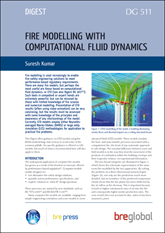Cart (0)

Book
Fire modelling with computational fluid dynamicsPDF Download
Publisher
BRE Electronic Publications
Author
S Kumar
Format
Subject / Keyword
DG511
Published Date
22-May-2009
ISBN
9781848060944
Fire modelling is used increasingly to enable fire safety engineering solutions to meet performance-based regulatory requirements. There are many fire models, but perhaps the most useful are those based on computational fluid dynamics (CFD). Such tools in competent or expert hands are extremely powerful, but can be misused by those with limited knowledge of fire science and numerical modelling. Presentation of CFD results (often using video animation) can be very convincing, but the results must be assessed with some knowledge of the principles and awareness of any shortcomings of the model. Currently, CFD models employ either Reynolds-averaged NavierStokes (RANS) or large eddy simulation (LES) methodologies for application to practical fire problems.
Illustrations
19 line drawings, 3 photos
Pages: 12
Contents
Introduction CFD models -RANS methodology -LES methodology -DNS methodology Fire-specific versus commercial software Ensuring correct use of computer models -Issues and concerns -CoMPAS -Best practice guidance (Non-dimensional heat-release-rate parameter Q*; Heat-release rate per unit area of fuel surface; Fire plume temperatures; Volumetric heat source versus combustion model; Radiative exchange from fire plume to its surroundings; Specification of free pressure boundary; Assessing the quality of the numerical solution; Effect of grid refinement; Analysis of CFD predictions against the characteristics of fire components) References Appendices: Step-by-step procedure for obtaining a converged numerical solution using the RANS CFD methodology; Considerations for setting up a numerical solution; Considerations for fire science and fire-safety engineering
Illustrations
19 line drawings, 3 photos
Pages: 12
Contents
Introduction CFD models -RANS methodology -LES methodology -DNS methodology Fire-specific versus commercial software Ensuring correct use of computer models -Issues and concerns -CoMPAS -Best practice guidance (Non-dimensional heat-release-rate parameter Q*; Heat-release rate per unit area of fuel surface; Fire plume temperatures; Volumetric heat source versus combustion model; Radiative exchange from fire plume to its surroundings; Specification of free pressure boundary; Assessing the quality of the numerical solution; Effect of grid refinement; Analysis of CFD predictions against the characteristics of fire components) References Appendices: Step-by-step procedure for obtaining a converged numerical solution using the RANS CFD methodology; Considerations for setting up a numerical solution; Considerations for fire science and fire-safety engineering
Book
Fire modelling with computational fluid dynamicsPDF Download
List Price £ 16.50
